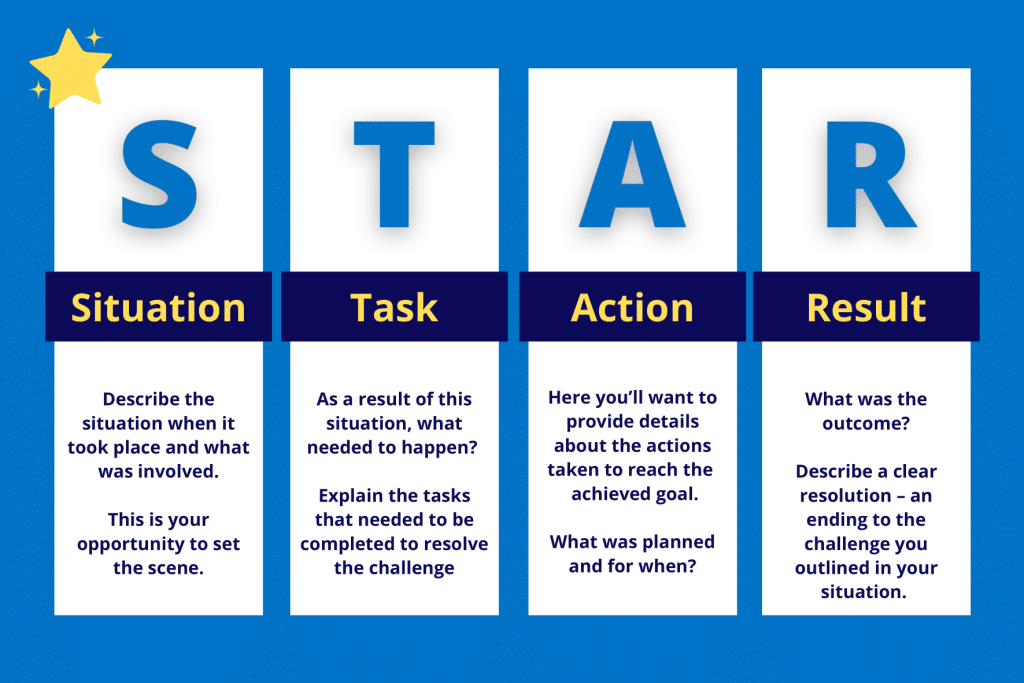 In today’s competitive job market, employers are looking for candidates who can effectively demonstrate their skills and experiences. One powerful method to do this is through the STAR interview technique. STAR stands for Situation, Task, Action, and Result, and it’s a structured approach to answering behavioral interview questions. In this blog post, we’ll delve into what the STAR interview technique is and how you can use it to ace your next interview.
In today’s competitive job market, employers are looking for candidates who can effectively demonstrate their skills and experiences. One powerful method to do this is through the STAR interview technique. STAR stands for Situation, Task, Action, and Result, and it’s a structured approach to answering behavioral interview questions. In this blog post, we’ll delve into what the STAR interview technique is and how you can use it to ace your next interview.
Understand the STAR Technique
The STAR interview technique is a structured way to respond to questions that require you to provide specific examples of your skills and abilities. It helps you provide clear, concise, and compelling answers by breaking your response down into four components:
- Situation: Begin by setting the stage. Describe the situation or context where the experience took place. Be specific and concise.
- Task: Explain the task or challenge you were facing. What were your responsibilities and objectives?
- Action: Detail the actions you took to address the situation or task. Emphasize your role and the steps you took, focusing on your skills and decision-making.
- Result: Conclude by outlining the outcomes of your actions. Share the positive results or lessons learned from the experience.
Identify Common STAR Question Categories
While STAR questions can cover a wide range of topics, there are some common categories you can prepare for in advance:
- Leadership: “Tell me about a time when you had to lead a team to achieve a challenging goal.”
- Problem-Solving: “Describe a situation where you had to find a creative solution to a problem.”
- Teamwork: “Give an example of a project where you collaborated effectively with colleagues.”
- Conflict Resolution: “Share a situation where you successfully resolved a conflict within your team.”
- Achievement: “Discuss an accomplishment you’re particularly proud of and the steps you took to achieve it.”
Prepare STAR Stories
To excel in the STAR interview technique, create a bank of STAR stories from your past experiences. Identify situations from your work, volunteer work, or personal life that demonstrate your skills and abilities in various areas. Tailor these stories to match the specific job requirements and company culture.
Structure Your Responses
During the interview, when faced with a STAR question, follow these steps:
- Begin with a brief but clear introdu
 ction of the Situation and Task.
ction of the Situation and Task. - Detail the Action you took, focusing on your skills and decision-making.
- Conclude by highlighting the Result or outcome, emphasizing your contributions.
- Keep your responses concise and relevant to the question asked, and use specific examples to illustrate your points.
Practice, Practice, Practice
Like any skill, the STAR interview technique improves with practice. Conduct mock interviews with a friend or use a mirror to practice your responses. Pay attention to your tone, body language, and timing. Aim to be confident and concise in your storytelling.
Conclusion
The STAR interview technique is a valuable tool to showcase your skills and experiences to potential employers. By understanding the structure and practicing your responses, you’ll be well-prepared to navigate behavioral interview questions with confidence. Remember to tailor your STAR stories to align with the job requirements, and don’t hesitate to use this technique to demonstrate why you’re the ideal candidate for the position.
Good luck with your interviews!
From the Red Chair Recruitment Team
#WeGetPepole

 ction of the Situation and Task.
ction of the Situation and Task.